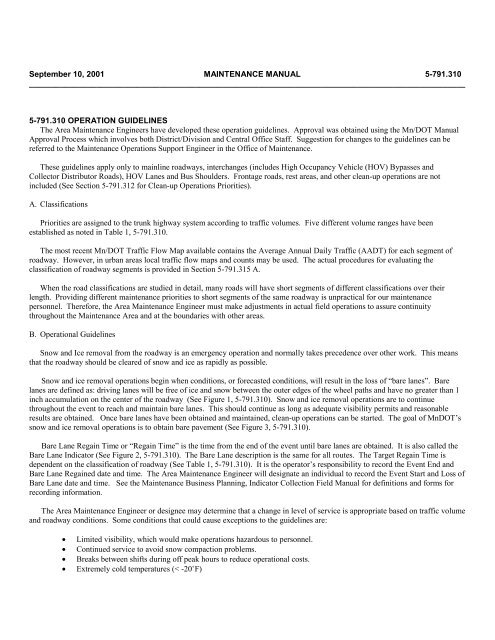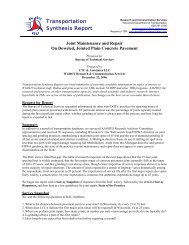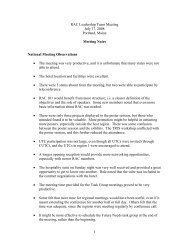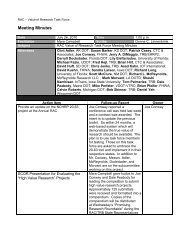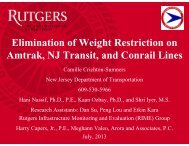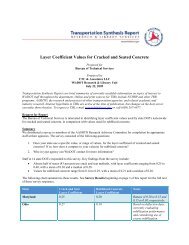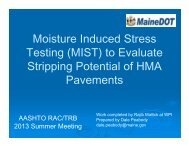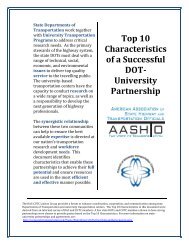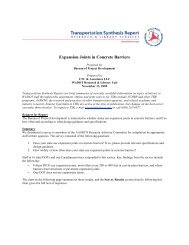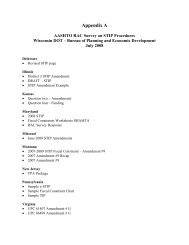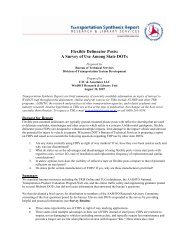Highway Maintenance Response Time Standards
Highway Maintenance Response Time Standards
Highway Maintenance Response Time Standards
You also want an ePaper? Increase the reach of your titles
YUMPU automatically turns print PDFs into web optimized ePapers that Google loves.
September 10, 2001 MAINTENANCE MANUAL 5-791.310_________________________________________________________________________________________________5-791.310 OPERATION GUIDELINESThe Area <strong>Maintenance</strong> Engineers have developed these operation guidelines. Approval was obtained using the Mn/DOT ManualApproval Process which involves both District/Division and Central Office Staff. Suggestion for changes to the guidelines can bereferred to the <strong>Maintenance</strong> Operations Support Engineer in the Office of <strong>Maintenance</strong>.These guidelines apply only to mainline roadways, interchanges (includes High Occupancy Vehicle (HOV) Bypasses andCollector Distributor Roads), HOV Lanes and Bus Shoulders. Frontage roads, rest areas, and other clean-up operations are notincluded (See Section 5-791.312 for Clean-up Operations Priorities).A. ClassificationsPriorities are assigned to the trunk highway system according to traffic volumes. Five different volume ranges have beenestablished as noted in Table 1, 5-791.310.The most recent Mn/DOT Traffic Flow Map available contains the Average Annual Daily Traffic (AADT) for each segment ofroadway. However, in urban areas local traffic flow maps and counts may be used. The actual procedures for evaluating theclassification of roadway segments is provided in Section 5-791.315 A.When the road classifications are studied in detail, many roads will have short segments of different classifications over theirlength. Providing different maintenance priorities to short segments of the same roadway is unpractical for our maintenancepersonnel. Therefore, the Area <strong>Maintenance</strong> Engineer must make adjustments in actual field operations to assure continuitythroughout the <strong>Maintenance</strong> Area and at the boundaries with other areas.B. Operational GuidelinesSnow and Ice removal from the roadway is an emergency operation and normally takes precedence over other work. This meansthat the roadway should be cleared of snow and ice as rapidly as possible.Snow and ice removal operations begin when conditions, or forecasted conditions, will result in the loss of “bare lanes”. Barelanes are defined as: driving lanes will be free of ice and snow between the outer edges of the wheel paths and have no greater than 1inch accumulation on the center of the roadway (See Figure 1, 5-791.310). Snow and ice removal operations are to continuethroughout the event to reach and maintain bare lanes. This should continue as long as adequate visibility permits and reasonableresults are obtained. Once bare lanes have been obtained and maintained, clean-up operations can be started. The goal of MnDOT’ssnow and ice removal operations is to obtain bare pavement (See Figure 3, 5-791.310).Bare Lane Regain <strong>Time</strong> or “Regain <strong>Time</strong>” is the time from the end of the event until bare lanes are obtained. It is also called theBare Lane Indicator (See Figure 2, 5-791.310). The Bare Lane description is the same for all routes. The Target Regain <strong>Time</strong> isdependent on the classification of roadway (See Table 1, 5-791.310). It is the operator’s responsibility to record the Event End andBare Lane Regained date and time. The Area <strong>Maintenance</strong> Engineer will designate an individual to record the Event Start and Loss ofBare Lane date and time. See the <strong>Maintenance</strong> Business Planning, Indicator Collection Field Manual for definitions and forms forrecording information.The Area <strong>Maintenance</strong> Engineer or designee may determine that a change in level of service is appropriate based on traffic volumeand roadway conditions. Some conditions that could cause exceptions to the guidelines are:Limited visibility, which would make operations hazardous to personnel.Continued service to avoid snow compaction problems.Breaks between shifts during off peak hours to reduce operational costs.Extremely cold temperatures (< -20˚F)


